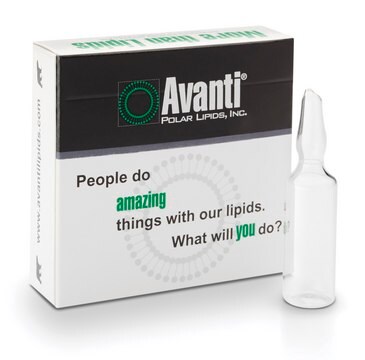890705P
Avanti
16:0-18:1 EPC (Cl Salt)
Avanti Research™ - A Croda Brand 890705P, powder
Sinonimo/i:
1-palmitoyl-2-oleoyl-sn-glycero-3-ethylphosphocholine (chloride salt)
About This Item
Prodotti consigliati
Stato
powder
Confezionamento
pkg of 1 × 10 mg (890705P-10mg)
pkg of 1 × 25 mg (890705P-25mg)
Produttore/marchio commerciale
Avanti Research™ - A Croda Brand 890705P
applicazioni
advanced drug delivery
Tipo di lipide
transfection
cationic lipids
Condizioni di spedizione
dry ice
Temperatura di conservazione
−20°C
Stringa SMILE
O=P(OCC[N+](C)(C)C)(OC[C@]([H])(OC(CCCCCCC/C=C\CCCCCCCC)=O)COC(CCCCCCCCCCCCCCC)=O)OCC.[Cl-]
InChI
1S/C44H87NO8P.ClH/c1-7-10-12-14-16-18-20-22-23-25-27-29-31-33-35-37-44(47)53-42(41-52-54(48,50-9-3)51-39-38-45(4,5)6)40-49-43(46)36-34-32-30-28-26-24-21-19-17-15-13-11-8-2;/h22-23,42H,7-21,24-41H2,1-6H3;1H/q+1;/p-1/b23-22-;/t42-,54?;/m1./s1
Descrizione generale
Applicazioni
- as a cationic lipid to explore the change in organization and dynamics of a membrane-bound fluorescent probe in host membranes of varying charge
- in the preparation of small unilamellar cationic liposomes
- in a novel albumin-associated lipoplex formulation to evaluate the antitumoral efficacy of immuno-gene therapy and “suicide” gene therapy
Azioni biochim/fisiol
Confezionamento
Note legali
Codice della classe di stoccaggio
11 - Combustible Solids
Scegli una delle versioni più recenti:
Certificati d'analisi (COA)
Ci dispiace, ma al momento non ci sono COA disponibili online per questo prodotto.
Se ti serve aiuto, non esitare a contattarci Servizio Clienti
Possiedi già questo prodotto?
I documenti relativi ai prodotti acquistati recentemente sono disponibili nell’Archivio dei documenti.
Il team dei nostri ricercatori vanta grande esperienza in tutte le aree della ricerca quali Life Science, scienza dei materiali, sintesi chimica, cromatografia, discipline analitiche, ecc..
Contatta l'Assistenza Tecnica.








